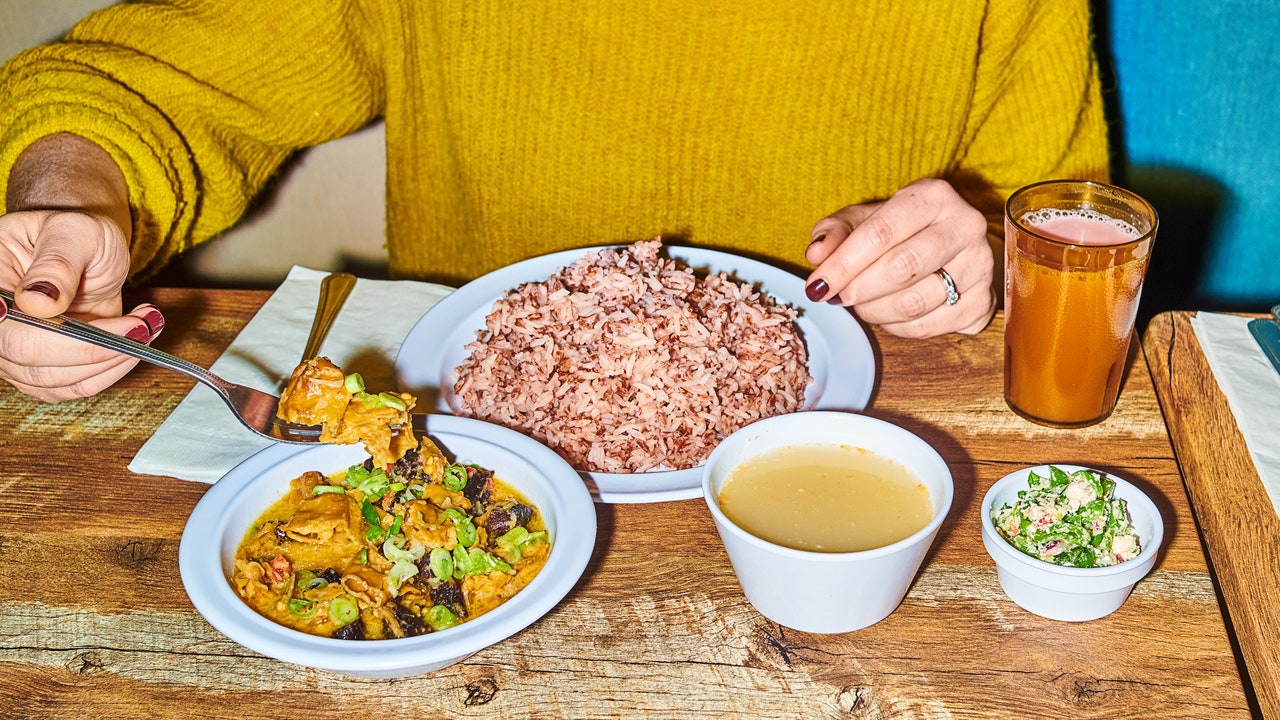The Butter and Momos of Bhutan, at Zhego

On my first visit to Zhego, a new Bhutanese restaurant in Woodside, the tiny dining room was full, so I took a seat on the front porch and asked if there was anything hot to drink, to offset the lingering spring chill. Cups of butter tea, cloudy, warm, and as salty as the sea, arrived quickly.
The butter in the tea was made from cow’s milk, as opposed to yak’s milk, as it would be in Bhutan, a small landlocked country in the eastern Himalayas. As Sonam Tshering Singye, a co-owner and the restaurant’s sole server, explained, it’s too expensive to import most fresh ingredients, though many of the kitchen’s drygoods do come from Bhutan. Bovine origin aside, the tea was an excellent introduction to the role of dairy products in Bhutanese cuisine, and at Zhego. “We love butter,” Singye said, delivering a small dish in which it starred, mixed with puffed rice and sugar for a crunchy, slightly fudgy palate-whetting snack meant to be scooped up with fingers.
The Bhutanese condiment known as azay can take many forms. As interpreted by the restaurant’s chef, Tobden Jamphel, it includes fresh green chili, cilantro, tamarillo (also known as tree tomato, which is grown in Bhutan), and feta cheese, which Singye and Jamphel—both immigrants who met in Bhutan and reconnected in a local basketball league—decided was the closest they could get to the farmer’s-style cheese ubiquitous in Bhutan. Feta anchors most of the menu’s extensive vegetarian options: melted into a creamy sauce to be slicked onto spears of tender fresh green chili, for ema datsi, the national dish of Bhutan; or onto thin slices of potato, for kewa datsi; or onto thick, slippery oyster mushrooms, for shamu datsi. In a dish called gongdo datsi, the feta remains a bit firmer, becoming pleasingly chewy and caramelized after being hard-scrambled with eggs, butter, and dried red chili. Mozzarella, with cabbage and cilantro, makes for a supple filling in the thick-skinned Himalayan dumplings known as momos, served with a rust-colored chili paste.
For beef momos, the ground meat is seasoned simply but generously with ginger and cilantro.
To temper the heat from all these chilies, there are cups of cool, tangy buttermilk in the warmer months, and of jaju, a milk-based soup flecked with silky spinach, when it’s colder. To temper the surplus of dairy, there’s beautifully mottled steamed red rice, and plenty of cheese-free dishes. Beef momos, stuffed with ground meat that’s seasoned simply but generously with ginger and cilantro, release a fragrant, flavorful broth. For puta, a dish from central Bhutan, buckwheat noodles are tossed with scrambled egg, chives, onions, and Sichuan peppercorn—which is also used to season waffled, chewy sheets of tripe, braised with ginger, dried red chili, and spring onions for a wonderful dish called goep paa. Air-dried preserved beef (shakum) or pork (sikum) is stir-fried with green beans, dried red chili, ginger, and tomato, although you can also get each of these in a feta-based broth.
To end the meal, in lieu of sweets, there’s a single, off-menu option called doma pani. It arrives as a plastic baggie of fresh betel leaves; a tiny packet of slaked lime (calcium hydroxide), dyed neon orange with turmeric; a few coconut chips; and half of a rock-hard “betel nut,” so called for the ritual, practiced all over Asia, of wrapping a piece of the nut with a smear of the lime in a betel leaf to chew. (The “nut” is actually the seed of the areca palm tree.) Taking a bite, with the full force of my molars, and churning the nut into papery dust was one of the wildest sensations I’ve experienced in my life, the flavor changing radically as I chewed: from bitter to peppery to funky to tannic and back around again. When I swallowed it (optional, according to Singye), a hard lump caught in my throat. I can’t recommend it, exactly—betel nuts are a proven carcinogen, I learned later, and a stimulant with addictive properties. And yet it’s part of the reason that I recommend Zhego, wholeheartedly, as a portal to another way of life. (Dishes $9.50-$16.99.) ♦










